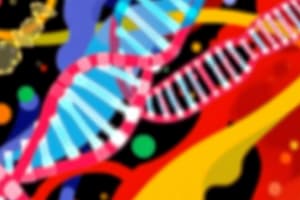Podcast
Questions and Answers
What is a nucleoside?
What is a nucleoside?
base and 5 carbon sugar
What is a nucleotide?
What is a nucleotide?
nucleoside and phosphate group
What is a purine?
What is a purine?
Adenine and guanine are the two nucleotides that are purines.
What is a pyrimidine?
What is a pyrimidine?
What are phosphodiester bonds?
What are phosphodiester bonds?
What is the structure of DNA?
What is the structure of DNA?
What is the steps in the process of DNA replication?
What is the steps in the process of DNA replication?
What is semiconservative replication?
What is semiconservative replication?
Where does replication originate in eukaryotic species?
Where does replication originate in eukaryotic species?
What are the two strands of DNA replication?
What are the two strands of DNA replication?
What is the role of primase binding to the lagging strand?
What is the role of primase binding to the lagging strand?
What is the role of the helicase?
What is the role of the helicase?
What are the types of RNA? What are their functions?
What are the types of RNA? What are their functions?
What is the structure of RNA?
What is the structure of RNA?
What is the order of functions of the types of RNA?
What is the order of functions of the types of RNA?
What is the function of tRNA?
What is the function of tRNA?
What is the structure of tRNA?
What is the structure of tRNA?
What are the types of RNA polymerase?
What are the types of RNA polymerase?
How are the types of RNA polymerase distinguished?
How are the types of RNA polymerase distinguished?
What are the steps of transcription?
What are the steps of transcription?
What does RNA polymerase binding include?
What does RNA polymerase binding include?
What is the process of initiation of transcription?
What is the process of initiation of transcription?
What is the process of transcription elongation?
What is the process of transcription elongation?
What is the process of termination of transcription?
What is the process of termination of transcription?
What is the process of specific regulation of transcription?
What is the process of specific regulation of transcription?
How do premature mRNA become mature mRNA?
How do premature mRNA become mature mRNA?
What are the features of the genetic code?
What are the features of the genetic code?
What are the steps in the process of translation?
What are the steps in the process of translation?
What is a codon and an anticodon?
What is a codon and an anticodon?
What is the course of action of the proteins after translation?
What is the course of action of the proteins after translation?
What is the difference between the free and bound ribosomes?
What is the difference between the free and bound ribosomes?
What is the structure of ribosomes?
What is the structure of ribosomes?
What are the post translational modifications on proteins?
What are the post translational modifications on proteins?
What are the types of mutation?
What are the types of mutation?
What is a point mutation?
What is a point mutation?
What is a missense mutation?
What is a missense mutation?
What is a nonsense mutation?
What is a nonsense mutation?
What is a silent mutation?
What is a silent mutation?
What is a frameshift mutation?
What is a frameshift mutation?
Flashcards are hidden until you start studying




